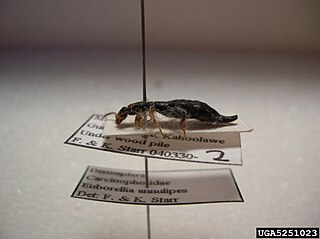
Anisolabididae is a family of earwigs, in the suborder Forficulina and the order Dermaptera. It is one of nine families in the suborder Forficulina, and contains thirty-eight genera spread across thirteen subfamilies.

Anisolabidinae, alternatively known as Carcinophorinae, Gonolabiinae, Placolabidinae, or Titanolabiinae, is a subfamily of earwigs that contains approximately twenty-five genera. Its existence was cited by Srivastava in the book Fauna of India Pt. 2, by Chen & Ma in Fauna Sinica, and by Henrik Steinmann in The Animal Kingdom. Although Steinmann cited the subfamily's name as Carcinophorinae, this is a synonym for the taxon.
Aborolabis is a genus of earwigs in the subfamily Anisolabidinae. It was cited by Srivastava in Part 2 of Fauna of India.
Apolabis is a genus of earwigs in the subfamily Anisolabidinae. It was cited by Srivastava in Part 2 of Fauna of India.

Brachylabis is a genus of earwigs in the subfamily Brachylabinae. It was cited by Srivastava in Part 2 of Fauna of India. It was also cited at an earlier date by Steinmann in his publication, The Animal Kingdom in 1986, 1989, 1990, and 1993, and by Chen & Ma in Fauna Sinica in 2004.

Carcinophora is a genus of earwigs in the subfamily Anisolabidinae. It was cited by Srivastava in Part 2 of Fauna of India.
Epilandex is a genus of earwigs in the subfamily Anisolabidinae. It was cited by Srivastava in Part 2 of Fauna of India.
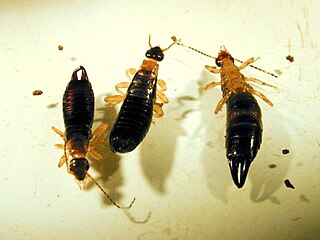
Euborellia is a genus of earwigs in the subfamily Anisolabidinae. It was cited by Srivastava in Part 2 of Fauna of India. Euborellia are small, dark-colored earwigs. Species can be difficult to distinguish from one another. There are about 50 species.
Isolaboides is a genus of earwigs, the sole member of the subfamily Isolaboidinae. It was cited by Srivastava in Part 2 of Fauna of India.
Platylabia is a genus of earwigs, the sole member of the subfamily Platylabiinae. It was cited by Srivastava in Part 2 of Fauna of India. It was also cited at an earlier date by Steinmann in his publication, The Animal Kingdom in 1986, 1989, 1990, and 1993, and by Chen & Ma in Fauna Sinica in 2004.
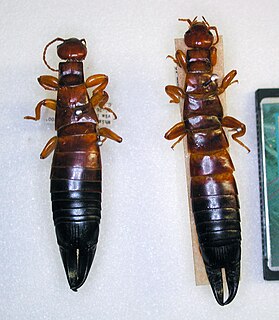
Titanolabis is a genus of earwigs in the subfamily Anisolabidinae. It was cited by Srivastava in Part 2 of Fauna of India. Among its species is the Australian T. colossea, which at about 5 cm (2.0 in) long is the largest certainly living species of earwig.
Anisolabis breviforceps is a species of earwig in the genus Anisolabis, the family Anisolabididae, the suborder Forficulina, and the order Dermaptera. It was first classified in 1979 by Brindle.
Anisolabis hawaiiensis is a species of earwig in the genus Anisolabis, the family Anisolabididae, the suborder Forficulina, and the order Dermaptera. The species is native to Hawaii, and was first classified by Brindle in 1979.
Anisolabis howarthi is a blind, troglobite species of earwig in the genus Anisolabis, the family Anisolabididae, the suborder Forficulina, and the order Dermaptera. The species is native to Hawaii, and was first classified by Brindle in 1979. According to a paper published by him in 1980 in the journal Pacific Insects, the species is first known true troglobite earwig; while there are other blind species that live underneath soil or humus, this is the first to actually inhabit a cave.

The seashore earwig is a species of earwig in the family Anisolabididae. It is native to eastern Australia and New Zealand. Similar both ecologically and taxonomically to the maritime earwig, this species is commonly found on beaches under stones and debris. It is a carnivore, feeding on millipedes, flies, and isopods such as woodlice. Like most other earwigs, the females care for their young during development, and the larva go through five instars before becoming adults. The species also has a negative phototaxis, meaning that it tends to move away from a light source. The species was first described in 1846 by Adam White.
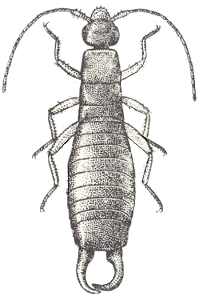
Anisolabis maritima, commonly known as the maritime earwig or the seaside earwig, is a species of earwig in the family Anisolabididae. Similar to the seashore earwig, this species can be found near the shore line, and is cosmopolitan. It can be found in almost all ecozones. Scientists believe that these earwigs originally came from Asia. Since then, however, they have been introduced to North America, and have now spread around the world due to international commerce.
Anisolabis mauiensis is a species of earwig in the genus Anisolabis, the family Anisolabididae, the suborder Forficulina, and the order Dermaptera.
Anisolabis pacifica, commonly known as the Pacific earwig, is a species of earwig in the genus Anisolabis, the family Anisolabididae, the suborder Forficulina, and the order Dermaptera.
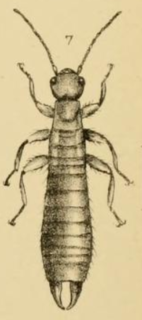
The Christmas Island earwig is a species of earwig in the family Anisolabididae.








